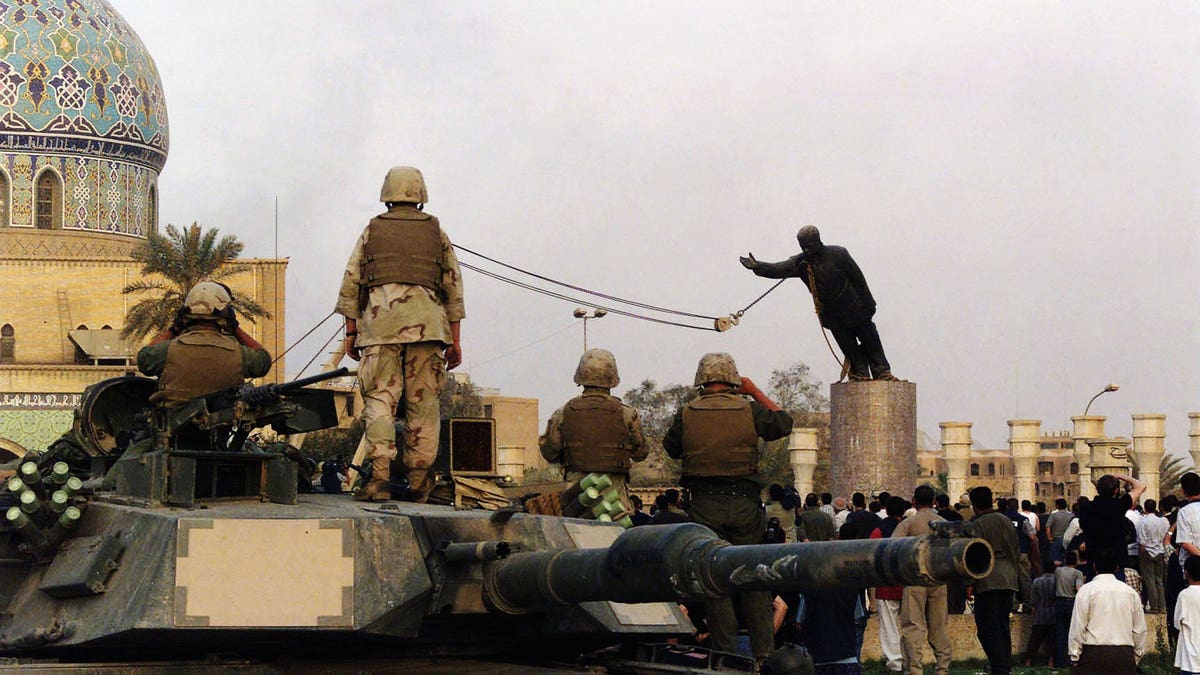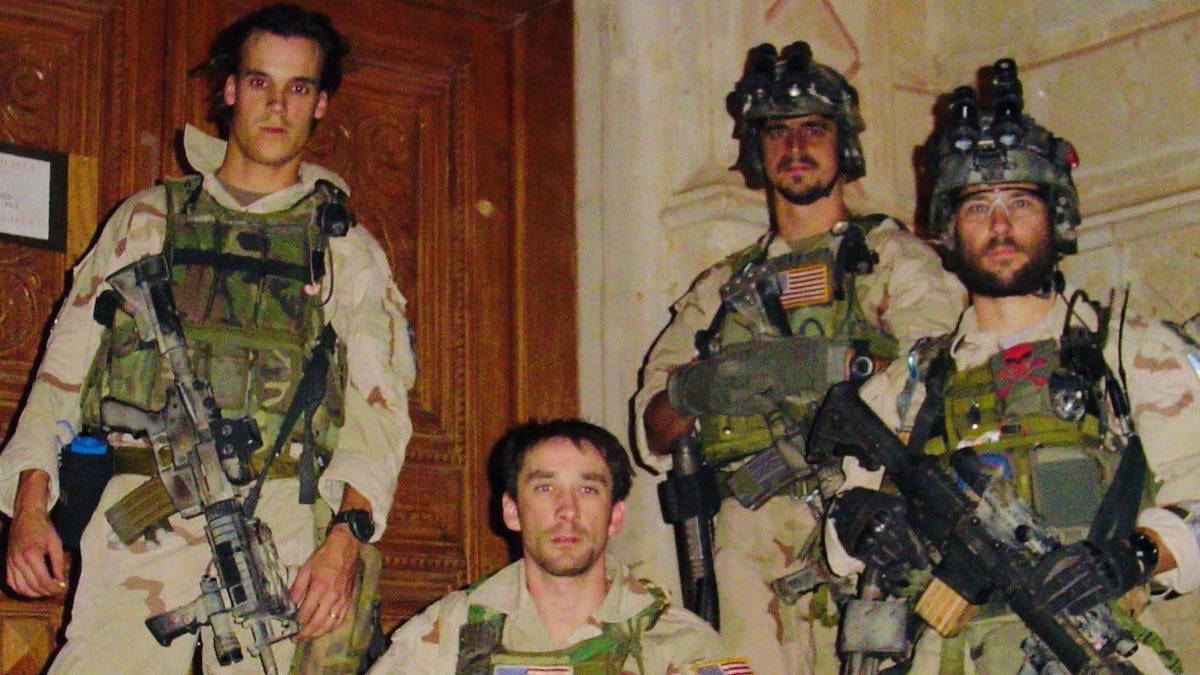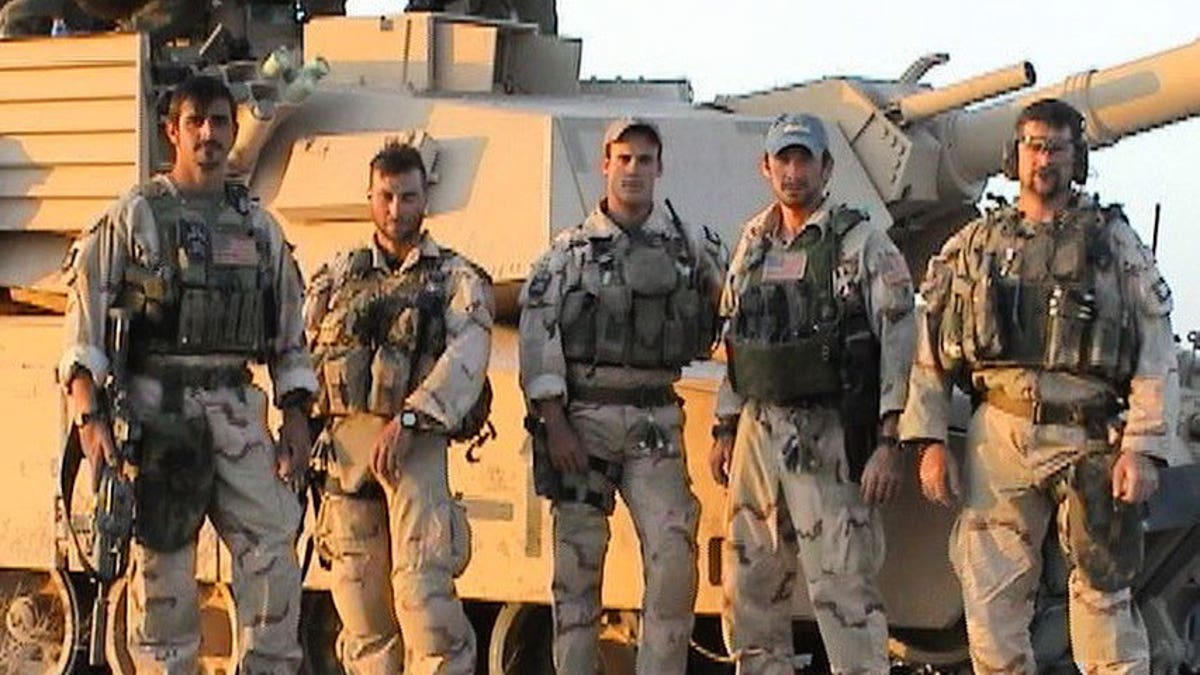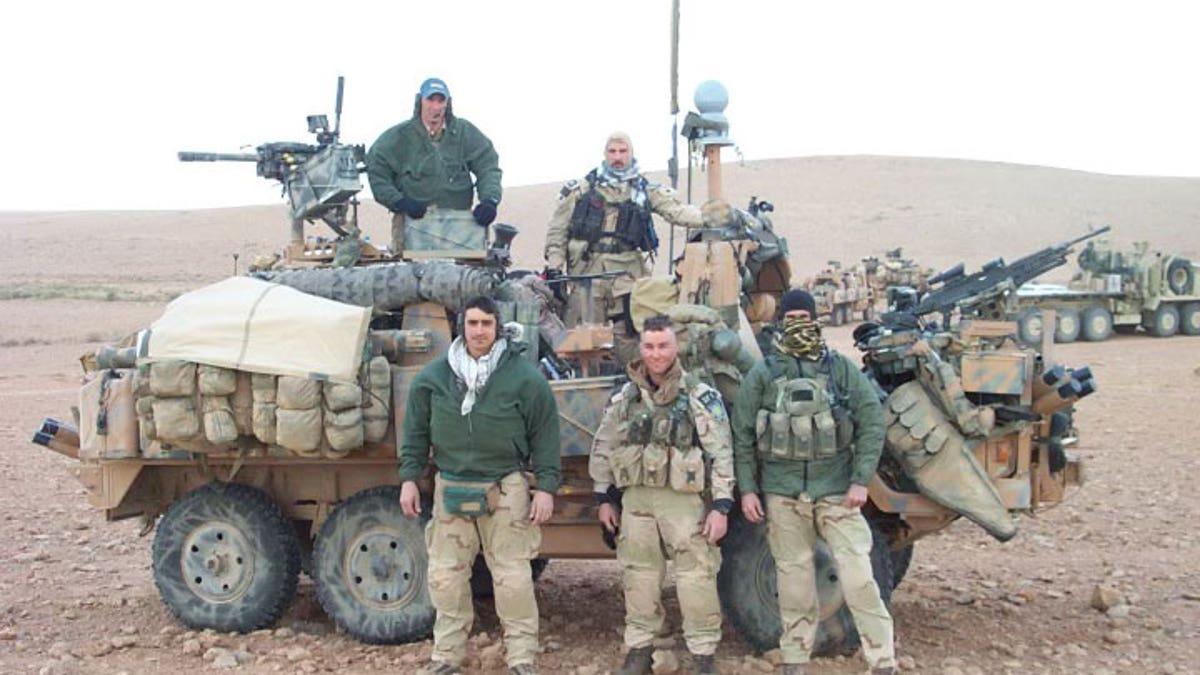Iraq War veteran wins Indiana primary, could become only Black Republican woman in Congress
Jennifer-Ruth Green, running to represent Indiana's 1st congressional district, joined 'Fox & Friends' to discuss her service and why she is running for Congress.
Baghdad, Iraq, March 20, 2003 – At 5:34 a.m., the United States, joined by British, Australian, and Polish forces, launched the "shock and awe" invasion of Iraq, opening one of the deadliest military engagements of the 21st century. The war would define then-President George W. Bush's legacy and change the Middle East's geopolitical landscape.
As Bush addressed the American people from the Oval Office, hellfire missiles reigned down on key governmental offices in the capital of Baghdad and forced citizens to seek shelter. The brutality and violence of the war were captured by 24-hour news channels broadcast to millions of people worldwide.
"We were running 24 hours the entire time, and I still remember the night the bombings of Baghdad began. That's really when it started, and [the coverage] never stopped after that," said Fox News Digital's Gary Gastelu, who was the bureau chief for Fox News in Kuwait before and in the months after the Iraq War. "We had reporters in Kuwait doing live reports from a studio we had set up in a hotel. But then we had several teams embedded with various military divisions. It was quite an operation."
The invasion came off the heels of the "Axis of Evil" State of the Union address from Bush five months after the September 11 attacks. During his speech, the former president called for action against foreign governments he accused of sponsoring Jihadi terrorism and stockpiling weapons of mass destruction. The term was well received, and while there was some opposition to the war in the early stages, the American public overwhelmingly supported an overthrow of Saddam Hussein's regime.
DEFENSE SECRETARY LLOYD AUSTIN MAKES UNANNOUNCED VISIT TO IRAQ

On March 20, 2003, United States forces bombarded the Iraqi capital of Baghdad with aerial strikes and coordinated a military offensive across the country. (Getty Images)
A USA Today/Gallup poll conducted four days after the war began found that 72% of Americans supported the invasion while only 25% disapproved. At the time, nine out of 10 Americans believed that U.S. forces would find conclusive evidence that Iraq had weapons of mass destruction, with 41% thinking it would be necessary to find the weapons to justify the war.
Over the coming months, coalition forces worked with Kurdish Peshmerga allies to cut off the regime from the north and moved through the south, seizing oil fields and capturing urban centers. Iraq's most critical oil assets were in the Al-Faw Peninsula along the Gulf Peninsula. British and U.S. Marine groups successfully captured the fields and the Umm Qasr port within days of the invasion before Saddam's forces could destroy them, causing a potential ecological disaster.
The land, aerial and amphibious invasion of Iraq had put the Baathist government on the run. A core element of the coalition forces' plans was to quell resistance by eliminating high-value military targets with precision airstrikes. However, the United States also sought to capture and prosecute Iraq's longtime government leaders, so the former regime could be discredited as they prepared to usher in a new era of western-backed democracy.
Meeting the Delta Force team
Key to this mission were the members of the most elite fighting force in the U.S. military – 1st Special Forces Operational Detachment–Delta, also known to the world as Delta Force. During the war, these men coordinated counter-terrorism operations, eliminated high-value targets and regularly engaged in direct enemy combat in some missions that remain classified today.
The night former President Bush unleashed the dogs of war, Delta Force operators 25-year-old Chris VanSant and 33-year-old Craig "Chili" Palmer crossed over the western desert of Iraq in search of the country's infamous weapons of mass destruction (WMDs) and to capture or kill longtime dictator Saddam Hussein.
Both men did not come from a long line of family who served in the military, nor were they pressured to enter service growing up. The call of duty came naturally to them when they were 18.
For VanSant, a Delaware native, the urge developed while listening to his grandfather, Charles Calloway, reflect on his service in the Asian-Pacific for the Army Air Corps in World War II.
"He was gone for nearly four years during World War II, and although it created a lot of issues in his life, he still talked about it in such a positive light about the people that he served with and what he got to do for his country," VanSant told Fox News Digital. "And I think that's probably the biggest contributing factor to why I went into the military."
Right after high school, VanSant entered the Army and, not long after, enrolled in Airborne school to join the army's 75th Ranger Regiment. After being convinced by a friend, the 21-year-old VanSant signed up for the Delta Force selection process. However, he failed to make it into the unit during his first round, but recruiters encouraged him to apply again in a year.
When VanSant tried again for a spot in the Army special forces, the country was reeling from the fallout of 9/11, and the idea of going to war suddenly became a reality for the 22-year-old Army Ranger.
"It was an incredible motivator. At the same time, I was probably a bit nervous in that I knew that if I was successful, I was probably going to war immediately upon completion of training."
In early 2002, VanSant formally joined the 1st Special Forces Operational Detachment-Delta after being trained as an operator during selection. Two weeks later, the 23-year-old VanSant was deployed to the first of his 11 combat deployments during the early days of the war in Afghanistan, landing at Bagram Airfield to meet his team for the first time. The moment was surreal for VanSant; most of the operators he met that night had formal combat experience, and the closest to his age was 30.

Delta Force team is pictured in front of a Pinzgauer on April 3, 2003, located somewhere east of the town of Rutba, Iraq, the day after the team lost an operator, Andy Fernandez, in battle. They decided to unsheathe their U.S. flags to show the enemy they were not discouraged one bit by their attack the day prior. Pictured from left to right, is Shawn Stevens, Craig Palmer, Mike Hefner, Brad Thomas, and Chris VanSant. (Courtesy of Chris VanSant )
"I was in awe. I felt like a boy amongst men when I first got there. I looked up to them for guidance and direction, and my team as a whole really kind of took me under their wing," Vansant recalled. "I was overwhelmed to be there, but I was excited and motivated and felt like I could bring some good things to the organization if I just paid attention and learned from the people around me."
One of the older operators who helped mentor the young VanSant was Palmer, a team leader in Delta Force with combat experience dating back to the United States invasion of Panama in 1989. Palmer was a part of the 1st Ranger Battalion at 19 before joining Delta Force in 1997. Vansant and Palmer served in a combat rotation in Afghanistan and three additional cycles in Iraq.
Palmer's experience in Afghanistan fighting the Taliban and Al-Qaeda was his first time facing insurgent jihadists before his team joined the opening invasion of Iraq. For him, one of the most dangerous experiences in Iraq was during the initial opening invasion against the regime.
IRANIAN-BACKED MILITIA LAUNCHES ROCKETS AT TURKISH BASE IN NORTHERN IRAQ
"We were still new to combat even though we went to Afghanistan. But our element was well under a hundred people on the ground, and we were surrounded by a hundred guys trying to hit us from multiple directions. We were so far in Iraq that we didn't have air support right away," Palmer told Fox News Digital. "You're woken up, and all of a sudden, you're surrounded in an area where you don't have anywhere to go, so it activates the fight or flight mentality. "
Hunting Saddam
During the initial invasion of Iraq, one of the essential priorities of coalition forces, besides hunting down the WMDs that were never found, was capturing the high-ranking members of the Arab Socialist Ba'ath Party to remove organized resistance and cripple the former regime. The U.S. intelligence apparatus created a deck of playing cards to identify the most-wanted government official in Iraq.
Saddam, along with various members of his family and inner circle, was at the top of the deck of cards as the ace of spades. Task Force 121 was a multi-service force comprising operators from various elite command groups, including Delta Force, with the sole mission of capturing these high-value targets.

By the fall of 2003, Iraq's former dictator Saddam Hussein was still on the run from coalition forces. (Getty Images)
In April 2003, Saddam's opulent palaces across the country were raided and seized by U.S. forces. Still, months into the invasion, the charismatic dictator, who acted as the country's iron-willed strongman for over two decades, was nowhere to be found. Saddam's sons, Qusay and Uday, were killed that summer by operators in Task Force 121 during a raid on their compound in the city of Mosul.
By September, VanSant and Palmer were focused entirely on the deck of cards, especially on Saddam, who became the main focus of the media's attention at the point and a headache for coalition forces. "[Saddam] quickly became the story after the fall of Baghdad," said Fox News' Gastelu. "That was really what it was about – tracking him down."
"As the months wore on in Fall 03, we were a bit fatigued from constantly pursuing this guy and coming up empty-handed," VanSant said.
However, in early December, their team received an intelligence report on Saddam's right-hand man Muhammed Omar al-Musslit. Musslit was the gatekeeper for Saddam, relaying the former dictator's orders to loyalist groups across the country and moving money to support those insurgents. Intelligence believed he was the key to finding Saddam's hideout.
SADDAM CAPTURED ‘LIKE A RAT’ IN RAID
On Dec. 12, 2003, VanSant and Palmer took part in the Delta Force raid on an upstairs apartment in Baghdad that was believed to be Musslit's location. The operators detained Musslit but were unsure if he was the correct target because he did not match the photos they had been given. However, the Delta Force team captured some interesting possessions, including serialized and sequential hundred-dollar bills.
VanSant noted that after Musslit was handed over to interrogation personnel back at Baghdad International Airport, they were woken several hours later in the middle of the night by an excited intelligence analyst that said, "He's spilling the beans. He's giving it up. He knows Saddam's location. You guys need to get ready to go."
Ad-Dawr, Iraq, Dec. 13, 2003 – Operation Red Dawn consisted of two groups; one to raid the house of Saddam's personal chef in Samarra and the second group to secure the chef's family farm outside the city in Ad-Dawr, where Saddam was believed to be hiding, according to information operators received Musslit. VanSant and Palmer were a part of the group that raided the chef's house and were met with no resistance.
Both missions were conducted simultaneously, securing the cook and the family farm. However, the operators could not find Saddam at the farm because Musslit, in a last-ditch effort to protect his leader, incorrectly identified a neighboring farm. Based on information from the personal chef, operators regrouped and launched another raid on the correct farmhouse.

Picture was taken on Nov 26, 2003, after an assault in Tikrit, Iraq. The picture is outside the team's Mission Support Site in Tikrit roughly two weeks before the capture of Saddam Hussein. Pictured left to right, Chris VanSant, Mike Hefner, Brad Thomas and Craig Palmer. (Courtesy of Chris VanSant)
Delta Force operators secured Saddam's hideout that night and discovered a spider hole after a soldier kicked over a piece of flooring. The hole was covered by a piece of Styrofoam with a rope attached. Operators initially planned to clear the hole with a frag grenade, but a disheveled Saddam emerged, surrendering with no resistance.
"I am Saddam Hussein. I am the president of Iraq, and I am willing to negotiate," Saddam told his captors after being pulled out from the hole and disarmed of a Glock pistol.
IRAQI PRIME MINISTER DEFENDS US TROOP PRESENCE, SAYS IT'S NECESSARY FOR FIGHTING ISIS
VanSant and Palmer confirmed that an operator responded by striking Saddam in the face and told the dictator, "President Bush sends his regards."
Facing the insurgency and personal battles
Following Saddam's capture, the public perception in the United States over how the war was progressing became more positive. The president's approval number increased by numbers similar to former President Reagan's gain after the 1983 invasion of Grenada, according to a poll taken at the time by Pew Research Centers. Moreover, some Delta Force operators on the ground believed their mission was complete and that there was a chance they would return home.
"I think a lot of us felt like maybe we were going home. Our task, which was the removal of an evil dictator, was complete. And that big service would do its thing for however long was asked of them," VanSant said. "I think that within 24 hours [after Saddam's capture], we were out on another mission."
Near the end of 2003, shortly after Saddam's capture, a deadly insurgency was fueled by sectarian violence between various ethnic and religious groups inside Iraq who were opposed to the U.S. occupation. For decades, Saddam's regime had kept the different factions at bay through sheer brutality and force. Iraq is a majority Shia Arab Muslim, while the Sunni Muslim minority accounts for over a quarter of the population and is broken up among Arabs and Kurds.
However, from 2004 until the initial withdrawal in 2011, U.S. military forces and Iraq's new coalition-backed government faced attacks from guerilla Sunni groups such as Al-Qaeda and Shia militias like Kata'ib Hezbollah, supported by Iran. Attacks were carried out against U.S. service members with improvised explosive devices, assassinations and urban warfare during street-by-street fighting in Fallujah and Ramadi.
The war with the insurgency was unlike anything elite U.S. operators had faced before and forced Delta Force to change combat procedures to adapt to the new war of attrition as foreign fighters flooded the country's rat lines. As a result of the sectarian violence, U.S. casualties were the highest between 2004 and 2007, with over 3,400 dead U.S. service members.
"With foreign fighters, when someone's sole goal in life is, is to kill Americans, and they're willing to blow themselves up to do it, things are just inherently going to get more violent, and they did," VanSant said while reflecting on the growing escalation in the country following Saddam's capture.
OBITUARY: SADDAM HUSSEIN, 1937, 2006
The political fallout from the insurgency torpedoed Bush's approval numbers, falling from 50% at the start of his second term to 24% by the time he left office in 2009. For Delta Force operators like VanSant and Palmer, the controversial turn of the war directly led to them being hamstrung on the battlefield by leaders in Washington.
"All of a sudden, we were told to stand down from higher, which higher at that time was [Secretary of Defense] on up," Palmer said. "It's sad when that happens because things start shifting on the battlefield, and we lose our momentum. We start getting hamstrung, and it changes the whole dynamic of things."
As the violence increased and the war became more divisive at home, operators like VanSant struggled with the traumas of frontline action, and those feelings made it difficult during his time away at home. During his service, VanSant was married to his first wife and had two daughters waiting for him at home. Keeping out the anxieties of war while trying not to be overwhelmed by every day at home became harder for VanSant after each of his eleven deployments.

The team in front of a tank at Objective Grizzley, later FOB Grizzley, outside Tikrit, Iraq, April 12, 2003. Operators had taken control of a former Iraqi Army base. Tanks were flown into our area via the H1 Airfield to provide security for their new staging base and to provide fire support as they prepared to enter Tikrit. Pictured from left to right, Brad Thomas, Craig Palmer, Chris VanSant, Mike Hefner and Shawn Stevens. (Courtesey of Chris VanSant)
"I think war got the better of me. Your life is like a rollercoaster. You live a life of extremes, these extreme highs and these extreme lows. The incredible rush of adrenaline in combat when you survive something, and then the incredible sadness of losing a teammate," VanSant told Fox News Digital. "It takes a pretty good toll on your personal life because you know how to function in combat because you're surrounded by a bunch of people with a single goal. So as time went by, at least for me, life at home became more difficult than life at war."
He added, "It started a vicious cycle of you come home, you miss your family, and you're happy to see them, and you're excited to see them. And then, as time passes at home, you get a bit overwhelmed by life back here, and you just kind of want to deploy again. And the time between being happy to be home and wanting to deploy again gets shorter as each rotation goes by until, eventually, you find yourself just preferring being at war."
Palmer, who completed 13 combat rotations throughout his career, reiterated a similar sentiment on the difficulty of transitioning from a deadly combat environment to everyday life at home.
U.S. FORCES CAPTURE SIX ISIS MILITANTS IN SERIES OF HELICOPTER RAIDS IN SYRIA
"Life was so much easier when you're dealing with one thing, and that one thing is just about doing your job is protecting yourself and your buddies. I didn't have to worry about paying this bill or taking the car to get inspected and getting the oil changed, you know? So when you're gone, and you're doing this job and living with a heightened sense of reality, you come home, and all of a sudden, it was more stressful being home more it was overseas sometimes," Palmer said.
In 2010, VanSant was diagnosed with a traumatic brain injury while suffering from the effects of post-traumatic stress, as well as being a severe insomniac, and he had developed an addiction to prescription pills. At this point in time, VanSant had a staff position within the organization and was no longer deployed as an operator.
"I was surrounded by guys that were like-minded and had similar experiences, and we could share those experiences with each other. And I think that was all part of the healing process for me. By the time I retired in 2015, I had a good handle on my issues, and it's one of the reasons that I post service do so many things to support, veteran charities and services," VanSant said.
Indeed, the rise of post-traumatic stress disorder (PTSD) and mental health issues remained an ongoing issue for service members across military branches serving in Iraq. A study by the Department of Veterans Affairs found that 15.7% of deployed Iraq and Afghan war veterans screened positive for PTSD. Meanwhile, researchers at the Costs of War Project concluded in another study that 30,177 veterans of the global war on terror have died by suicide compared to the 7,057 service members who died while deployed.
Life after the Iraq war
After retiring from Delta Force in 2015, VanSant served as the chief operating officer for Tyr Tactical, a U.S. manufacturer of body armor, ballistic shields, and tactical equipment, but stepped down after seven years to address hereditary heart issues. He currently runs his own consulting firm that specializes in government acquisition and product development with a focus on military and law enforcement programs.
VanSant, along with his wife Robin, support various veteran charity operations, such as the All Secure Foundation, where Chris serves as an active board member. The non-profit works to end the stigma of veterans seeking help for post-traumatic stress and other mental health issues. As for his own trauma, VanSant notes that while the scars of war will never leave him, he has come a long way in dealing with those issues.

This picture was taken at the border of Saudi Arabia and Iraq right before the initial invasion on March 19, 2003. Pictured standing together on the right are Craig Palmer and Chris VanSant. (Courtesy of Craig Palmer)
"There's no such thing as 100% recovery, or I'm cured of the cumulative effects of those things. I think the difference that time and education provides is that you discover ways to deal with it and ways to pull yourself out when it starts to get bad," VanSant concluded. "You're going to carry elements of that with you for the rest of your life. The key is talking about them and coming up with healthy and effective ways to deal with those issues and make your life better."
Palmer, who many of his fellow service members still refer to him by his nickname "Chili," retired in 2014. He currently works for the Sentinel Foundation, a non-profit dedicated to ending underage child trafficking. When asked how he feels about his service over two decades later, Palmer notes that he is proud of what he did and only regrets he could not do more to protect his friends.
"We wanted to defend this nation. I wouldn't have traded it for anything. I think today; we lose sight of what this country stands for. And I think people need to get back to that [unity]," Palmer added.
In 2011, U.S. troops officially withdrew from Iraq but returned in 2014 to defend the Iraqi government after the start of the second sectarian civil war involving ISIS. The original coalition formally concluded its mission in Iraq in 2021, but U.S. military forces remain in the country to this day to provide aid and support the Iraqi army from jihadist threats.
CLICK HERE TO GET THE FOX NEWS APP
Saddam, the man Palmer and VanSant spent the prime of their career hunting, was convicted by an Iraqi court for crimes against humanity and sentenced to death by hanging. He was executed on Dec. 30, 2006.





















